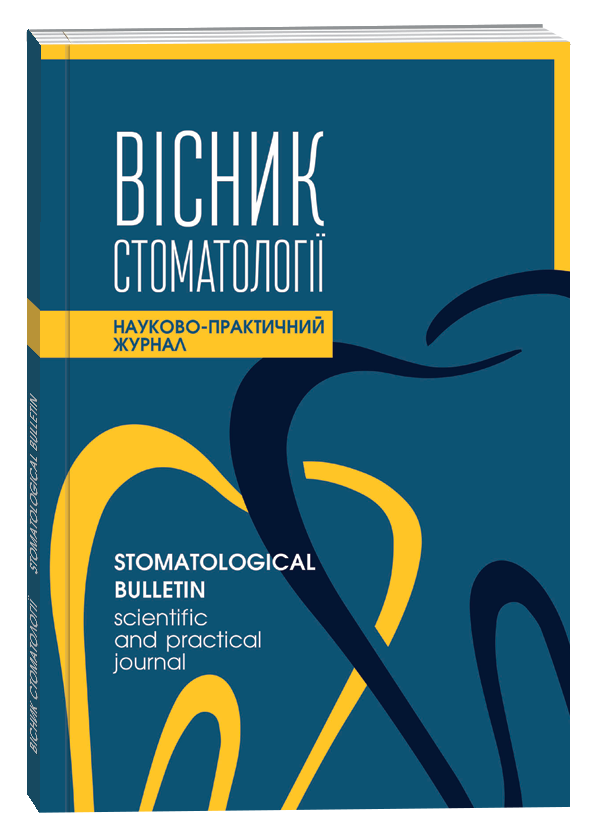PECULIARITIES OF THE COURSE AFTER THE OPERATIVE COURSE OF PATIENTS AFTER DENTAL IMPLANTATION ON THE BACKGROUND OF THE PATHOLOGY OF THE HEPATOBILIER SYSTEM
DOI:
https://doi.org/10.35220/2078-8916-2022-45-3.9Keywords:
treatment, dentistry, stomatology, adentia, dental implantation, clinical manifestations, healing, maxillofacial area, pathology of the hepatobiliary system.Abstract
Purpose of the study. The purpose of the study is to investigate the features of the postoperative period in dental intraosseous implantation in pathology of the hepatobiliary system. Materials and methods. In the course of the work, 23 patients were examined and intraosseous dental implants from Mega Gen were installed. The age of patients ranged from 19 to 42 years. The studied patients were divided into 2 groups: the first – control (11 patients) – without pathology of the hepatobiliary system; the second – experimental (12 patients) included patients with disorders of the hepatobiliary system. Men and women were equal in groups. All patients underwent clinical trials of local status. Local status was assessed in patients by registering clinical signs of inflammation observed in the area of surgery at 3, 7, 10, 14 days: pain, redness, edema. For all patients, the manifestation of clinical signs was evaluated in points as follows: 1 point – no sign, 2 – slightly expressed, 3 – expressed, 4 – significantly expressed. Patients in the first and second groups received the same medication. Standard treatment in patients in the postoperative period included: cefadox 200 2 times a day, nimesil 1 sachet 3 times a day, ascorutin 1 tablet 3 times a day, loratadine 1 tab. 1 time a day. Standard treatment patients in the postoperative period took 5-7 days. Results. Postoperative observations of the dental implant site showed that in the group of patients with pathology of the hepatobiliary system, healing had a significantly negative dynamic. All local signs that were taken into account in the observation showed a significant negative impact of pathology of the hepatobiliary system on the signs of wound healing after dental implantation. Analyzing the obtained indicators of clinical manifestations of pain, hyperemia, edema, their more positive dynamics is noticeable in the group of patients without pathology of the hepatobiliary system, and their synchronicity should be noted. In particular, on day 7 in the first (control) group of patients after dental implantation edema was registered in 44.8 % of cases, and in patients of the second group – in 74.3 % of cases, and on day 14 – in the first group of patients after dental implantation the manifestation of edema decreased to 24.2 % of cases, and in patients of the second group to 42.4 % of cases. This dynamics of edema in the area of surgical intervention during dental implantation indicates a more positive dynamics of recovery of patients who do not have pathology of the hepatobiliary system. Conclusions. Clinical manifestations of postoperative wound healing during dental implantation depend on concomitant pathology. In particular, the pathology of the hepatobiliary system adversely affects the clinical course of postoperative wound healing during dental implantation, prolonging for 3-4 days. The peculiarities of the postoperative healing of soft and hard tissues in the area of dental implantation may further affect the engraftment of the implant. Clinical signs of healing have a greater positive dynamic in patients without pathology of the hepatobiliary system. At pathology of hepatobiliary system in the postoperative period it is expedient to carry out its correction.
References
Добровольська В.О. Сучасний погляд на ускладнення в дентальній імплантації. Клінічна стоматологія. 2019. № 3. С. 43-51.
Поліщук С.С, Скиба В.Я., Левицький А.П., Шувалов С.М. Експериментальне дослідження впливу квертуліну на процеси загоєння травматичних пошкоджень слизової оболонки порожнини роту щурів при порушенні функції гепатобіліарного тракту. Инновации в стоматологии. 2015. № 4 (10). С. 9-16.
Іщенко П.В. Борисенко А.В. Застосування субперіостальної імплантації в сучасній стоматології. Сучасна стоматологія. 2018. № 4. С. 93.
Павленко О.В. Застосування фармакологічного супроводу та магнітно-лазерної терапії в пацієнтів з генералізованим пародонтитом і дентальною імплантацією. Сучасна стоматологія. 2013. № 2. С. 40–46.
Савчук О.В., Краснов В.Ю., Юрженко А.В., Азоді Фар С. Прогнозування успішності стоматологічної імплантації в пацієнтів з дефектами зубних рядів на тлі хронічного генеразізованого пародонтиту. Сучасна стоматологія. 2021. № 5. С. 64-66.
Проць Г.Б., Пюрик В.П. Сучасні підходи до хірургічного лікування хворих на генералізований пародонтит із використанням дентальних імплантатів. Клiнiчна стоматологія. 2017. № 4. С. 4-10.
Демкович А.Є., Дмітрієв М.О., Поліщук С.С., Якимчук М.М. Сучасні методи лікування перімплантиту. Клінічна стоматологія. 2020. № 1 (30). С. 43-51.
Черненко В.М., Любченко О.В. Можливість використання методики безпосередньої імплантації з негайним навантаженням з використанням остео- пластичних матеріалів (огляд літератури). Журнал клінічних та експериментальних медичних досліджень. 2017. № 5 (4). С. 995 – 1005.
Шнайдер С.А., Асмолова А.О., Асмолова К.О. Віддалені ускладнення дентальної імплантації: роль якості лицьового скелету. Вісник стоматологія. 2018. № 2. С. 47-50.
Polishchuk S.S., Skyba V.Ya., Davydenko I.S. et al. Histological changes of bone tissue in the perforation defect site of the rat mandibule when using hepatoprotector in odstructive hepatitis. World of medicine and biology. 2020. Vol. 16, № 2 (72). P. 193-198.
Radnai M. Stress in the mandible with splinted dental implants caused by limited fl exure on mouth opening: an in vitro study. Int. J. Exper. Dent. Sci. 2012. № 1. P. 8–13.
Skyba V.Ya., Polishchuk S.S., Davydenko I.S. et al. Dynamics of morphometric bone changes in the site of mandibular perforation defect in rats with toxic hepatitis and use of hepatoprotector. World of medicine and biology. 2020. Vol. 16, № 2 (72). P. 198-203.









